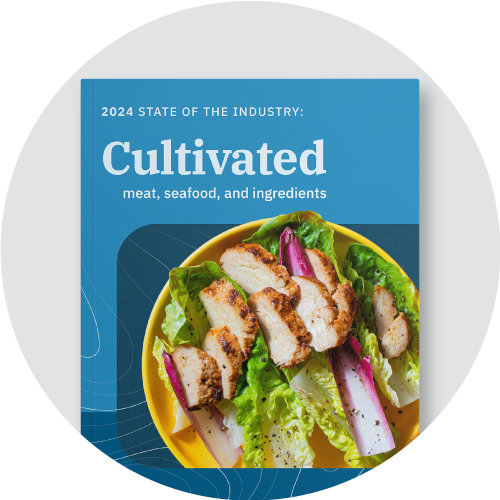
State of the Industry: Cultivated meat, seafood, and ingredients
This report covers the commercial landscape, consumer insights, investments, regulatory developments, and scientific progress in the cultivated meat and seafood industry.

Explore new data and industry insights
Executive summary
In 2024, cultivated meat made noteworthy progress while also facing numerous obstacles, both new and continuing. The year was marked by diversified new products, impactful scientific breakthroughs, and new regulatory progress. Despite those successes, cultivated meat also continued to face technical and cost hurdles, declining investments, and regulatory bans, raising questions about consumer choice and food freedom in several countries around the world.
Like many transformative innovations in their early days, cultivated meat faces a set of common, predictable challenges. Yes, these challenges are big. But in 2024, several bright spots emerged.
Our annual State of Alternative Proteins series equips food system stakeholders with an in-depth understanding of the alternative protein sector, including its biggest challenges and major opportunities. This report, Cultivated meat, seafood, and ingredients details the major innovations and developments that moved the field of cultivated meat forward in 2024.
Report highlights
- Industry partnerships
- Infrastructure developments
- Fresh consumer insights
- Private investment data and insights
- New scientific and technological research
- Public investments
- Regulatory updates
- Industry outlook
Key developments
This report provides a comprehensive global analysis of the growing cultivated meat and seafood industry including new partnerships, consumer insights, investments, scientific progress, and government and regulatory developments. Highlights featured in the report include:
Commercial landscape
Path-to-market milestones
- Two cultivated meat innovation hubs, facilities in which companies can de-risk processes and demonstrate commercial viability, opened or were announced in 2024. These facilities can help lower companies’ scale-up costs.
- Companies partnered to utilize AI to develop processes and technology to reduce the cost of cultivated meat. Others agreed to co-develop equipment to improve cultivated meat’s unit economics and establish methods for optimizing cell growth.
- GOOD Meat, the cultivated meat division of the U.S. plant-based food company Eat Just, launched GOOD Meat 3, the first product containing cultivated meat (3%) to be available in retail, in the frozen section of Huber’s Butchery in Singapore.
Investments
All-time investment reaches $3.1 billion
- The two largest cultivated meat deals in 2024 were Prolific Machines’ $54.6 million Series B and Mosa Meat’s €40 million ($42.9 million) round.
- Though both deals were larger than 2023’s largest round of $35 million, neither ranks among the top 10 largest private investments in the sector. The investment environment of the past two years has been fundamentally different from the low-interest-rate period of 2020 to 2022 when the 10 largest cultivated meat and seafood rounds were raised.
- Since 2013, privately held companies involved primarily in the cultivated meat sector have raised more than $3 billion. For comparison, in the first three quarters of 2024 alone, global private equity and venture capital funding into the electric vehicle sector totaled $3.3 billion, eclipsing all-time cultivated meat funding.
Science and technology
Growing scientific ecosystem
- Large-scale production systems are planned or coming online with the support of established industrial manufacturers: Vow is manufacturing cultivated quail in a 15,000 L bioreactor, with a 20,000 L bioreactor coming online soon, the largest production scale reported to date.
- Global innovation in alternative proteins continues to expand at dedicated hubs, including The Bezos Centers for Sustainable Protein, the Alternative Protein Technology Innovation Center of the China State Administration for Market Regulation, the UK’s four dedicated alternative protein research centers, and India’s IKP Knowledge Park’s Centre for Smart Protein and Sustainable Material Innovation.
- The Cultured Hub in Switzerland, the largest cultivated meat contract development and manufacturing organization (CDMO) in Europe, opened its doors. Additionally, Tufts University received a $2.1 million grant from Massachusetts state funds to establish pilot scale-up facilities on campus, and Fermbox/BBGI made progress on establishing the first CDMO facility in Thailand.
Government and regulation
New public investment and governmental support for cultivated meat and seafood
- The sole entity tasked with legal authorization to issue Halal certificates in Singapore declared that cultivated meat can be Halal. In other countries, the first-ever regulatory submissions were made or accepted for cultivated meat and are undergoing the review process (EU, South Korea, and Thailand).
- The government of India made a billion-dollar commitment to develop domestic biotechnology capabilities that included cultivated meat in their wider scope, while Japan, New Zealand, Singapore, and South Korea funded public and private research to advance cultivated meat science.
- There were 14 bills introduced to ban cultivated meat across 12 states in 2024, and all but two failed to pass. In March 2024, Florida’s legislature became the first in the country to vote to ban cultivated meat, with the governor signing the bill into law on May 1. Also in May, Alabama enacted its own bill banning the production and sale of cultivated meat. Litigation challenging the Florida ban is currently ongoing.

Download our at-a-glance summary
Don’t have time to read the full report? Check out our summary for a quick view of the highlights and key data points from this report.
Hear from our experts
This webinar covers the commercial landscape, consumer insights, investments, regulatory developments, and scientific progress in the cultivated meat and seafood industry.
Find companies focused on cultivated meat and seafood
These companies focus primarily on cultivated meat and seafood. This database is dynamically updated; the total number of companies may differ slightly from what has been reported in the State of the Industry report as we continuously improve our dataset. This list is intended to be as comprehensive as possible, but should not be considered exhaustive. You can learn more about these companies in our company database.
Are we missing something? Let us know about an update to a company’s record by filling out our company database edits form or submitting a new company using this form.
Find cultivated meat and seafood production facilities
These production facilities have cultivated meat or seafood production capacity. This database is dynamically updated; the total number of facilities may differ slightly from what has been reported in the State of the Industry report as we continuously improve our dataset. This list is intended to be as comprehensive as possible, but should not be considered exhaustive.
Are we missing something? Let us know by filling out this form to add a cultivated meat or seafood-focused production facility to the database.

Page
The science of cultivated meat
Learn about the science of cultivated meat and the challenges that must be addressed for commercial production.
More resources

Cultivated meat media kit
Cultivated meat stands to transform our global food system. Learn the basics and dig into the latest updates on this game-changing protein alternative.

Cultivated meat LCA/TEA report analysis
Recent studies show cultivated meat could have reduced environmental impacts and be cost-competitive with some forms of conventional meat.

Trends in cultivated meat scale-up and bioprocessing
This report presents findings from a 2022-2023 survey of 30 cultivated meat industry stakeholders and covers current capabilities, future needs, bioprocessing, facilities, equipment costs, and food safety practices.
Get fresh insights sent to your inbox!
The Alternative Protein Opportunity is a tool for food industry insiders and includes sales, consumer, and investment data as well as distribution, science, policy updates, and other timely insights. The newsletter is sent monthly. You’ll also receive bulletins about events, resources, and reports from GFI’s experts.
"*" indicates required fields
